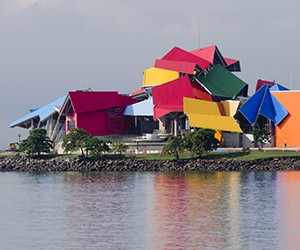With exhibits designed in collaboration with scientists from the University of Panama and the Smithsonian Research Institute, the Museo de la Biodiversidad (Biodiversity Museum; more commonly referred to simply as the Biomuseo) is packed with engaging visuals about the origins of Panama and the rest of the planet, as well as ideas on how to save it for future generations. But the part of the Museum that seems to attract the most attention is the colorful architecture, and the star architect who created it: Frank Gehry.
Gehry’s first-ever creation in Latin America, the 44,100-square-foot Biomuseo is an eye-catching jumble of jutting angles and edges, perched scenically on a six-acre park on the Amador Causeway, with inspiring views of the entry to the Panama Canal as well as the city skyline. Open to the public since October 2014, the facility hosts permanent and temporary exhibitions, including eight galleries—created by Canadian designer Bruce Mau, founder of the Institute Without Boundaries—that focus on the origin of the Panamanian isthmus and its role in the biodiversity of the planet. Among the most interesting spaces is Panamarama, a three-story projection room with 10 screens that showcase the natural beauty of the nation (at one point, you’ll see video of ants crawling on the floor beneath your feet).
Also visually striking is the exhibit called Worlds Collide, which is dominated by life-size representations of living and extinct species of animals that have journeyed between North America and South America. The exhibit called Oceans Divided will surely also attract attention when complete, thanks to its two gigantic aquariums that will be filled with marine life from both the Pacific Ocean and the Caribbean Sea, both of which share coastline with Panama.
Private event spaces allow groups to enjoy the exhibits and also take in the impressive views of the surrounding area. Options include an open-air upper and lower atrium (the largest of which accommodates 624 people), a cafeteria that can seat 112, an exhibit hall for 230 and a 350-seat auditorium outside the main museum. Event possibilities include cocktail parties, buffet and seated meals, presentations and concerts. The Biomuseo will be especially well positioned for events when the Amador convention center opens, just down the street.



